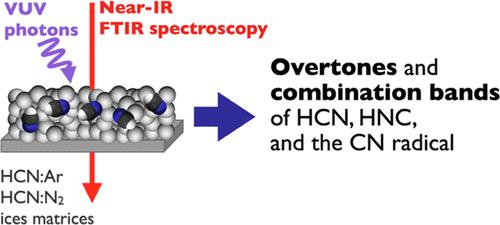当前位置:
X-MOL 学术
›
ACS Earth Space Chem.
›
论文详情
Our official English website, www.x-mol.net, welcomes your feedback! (Note: you will need to create a separate account there.)
Near-Infrared Vibrational Frequencies of HCN, HNC, and CN in N2 and Ar Ice Matrices
ACS Earth and Space Chemistry ( IF 3.4 ) Pub Date : 2024-02-06 , DOI: 10.1021/acsearthspacechem.3c00287 Edith C. Fayolle 1 , Paul V. Johnson 1 , Robert Hodyss 1 , Xu Zhang 1, 2 , Stanley P. Sander 1
ACS Earth and Space Chemistry ( IF 3.4 ) Pub Date : 2024-02-06 , DOI: 10.1021/acsearthspacechem.3c00287 Edith C. Fayolle 1 , Paul V. Johnson 1 , Robert Hodyss 1 , Xu Zhang 1, 2 , Stanley P. Sander 1
Affiliation

|
The surfaces of cold objects in the outer Solar System, like those of Kuiper Belt objects, are often dominated by volatile ices such as nitrogen, methane, and carbon monoxide. As these icy surfaces are subjected to a variety of energetic particles and ultraviolet radiation, HCN and its irradiation products may form and thus contribute to the vibrational bands observed by telescopic and in situ near-infrared observations. Here, we provide frequency assignments for most near-infrared vibrational features (8000–4000 cm–1, 1.25–2.5 μm) of HCN, HNC, the CN radical, and their 13C isotopologues in N2 and Ar ice matrices. These were derived from transmission spectra of solid isolated HCN subjected to UV photolysis at 14 K. These frequencies can be used to search for HCN and its irradiation products in archival or in future observational data sets and thus further our understanding of the composition and the energetic processing of icy surfaces in the outer solar system.
中文翻译:

N2 和 Ar 冰基质中 HCN、HNC 和 CN 的近红外振动频率
太阳系外的冷天体(如柯伊伯带天体)的表面通常主要由挥发性冰组成,例如氮气、甲烷和一氧化碳。由于这些冰冷的表面受到各种高能粒子和紫外线辐射的影响,HCN及其辐射产物可能会形成,从而有助于望远镜和原位近红外观测所观察到的振动带。在这里,我们提供了HCN、HNC、CN 基团及其在 N 2和 Ar 冰矩阵中的13 C 同位素异体的大多数近红外振动特征(8000–4000 cm –1 、1.25–2.5 μm)的频率分配。这些频率源自固体分离的 HCN 在 14 K 下经受 UV 光解的透射光谱。这些频率可用于在档案或未来的观测数据集中搜索 HCN 及其辐照产物,从而进一步了解其组成和能量处理太阳系外冰冷的表面。
更新日期:2024-02-06
中文翻译:

N2 和 Ar 冰基质中 HCN、HNC 和 CN 的近红外振动频率
太阳系外的冷天体(如柯伊伯带天体)的表面通常主要由挥发性冰组成,例如氮气、甲烷和一氧化碳。由于这些冰冷的表面受到各种高能粒子和紫外线辐射的影响,HCN及其辐射产物可能会形成,从而有助于望远镜和原位近红外观测所观察到的振动带。在这里,我们提供了HCN、HNC、CN 基团及其在 N 2和 Ar 冰矩阵中的13 C 同位素异体的大多数近红外振动特征(8000–4000 cm –1 、1.25–2.5 μm)的频率分配。这些频率源自固体分离的 HCN 在 14 K 下经受 UV 光解的透射光谱。这些频率可用于在档案或未来的观测数据集中搜索 HCN 及其辐照产物,从而进一步了解其组成和能量处理太阳系外冰冷的表面。



























 京公网安备 11010802027423号
京公网安备 11010802027423号